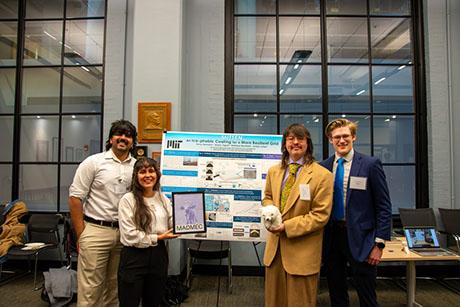Student Spotlight: John Lewandowski (PhD Candidate)
Low-Cost Diagnostic Devices for the Developing World
When PhD candidate John Lewandowski started working on a low-cost device for the rapid diagnosis of malaria as a graduate student at Case Western Reserve University (CWRU), it was already a fairly well known fact that the disease’s biomarkers were magnetic. An interesting characteristic, to be sure, but one that unfortunately hadn’t amounted to much.
“The problem had always been that the rate of cost and sensitivity were going in the same direction,” says Lewandowski. “Engineers would design a device that was very sensitive but also very costly, or conversely, less costly but also less sensitive.”

John Lewandowski, a PhD candidate in Associate Professor John Hart’s research group.
According to Lewandowski, a PhD student in Associate Professor John Hart’s research group, it’s true that cost and sensitivity are the two most important factors of a successful malaria diagnosis device, but only if the cost is low while the sensitivity is high.
Lewandowski designed a device that was able to balance that relationship and steer it in the right direction.
The trick, he says, is using a low-cost consumable, the object that holds the blood sample in the device. Magnets in the device pulse a magnetic field across the consumable with permanent magnets rotating around the sample, so the thinner (and cheaper) the consumable, the closer the magnets are and the higher the overall accuracy.
“This is a very low-cost approach,” explains Lewandowski, “because it quickly aligns the hemozoin and then allows them to randomize. I studied the hemozoin’s relaxation rate to design a system that allowed them to relax into a randomized form just long enough to get a readable signal, but not so long that the power requirements or magnetic field reached an inflection point and made the device too expensive. This innovation really separates it from previous techniques that only looked for the magnetic property in the blood.”
When malaria parasites make their way into the bloodstream through the bite of a mosquito, they start to digest the red blood cells. But there is part of the hemoglobin they aren’t able to digest – which then becomes polymerized and magnetic, with unique optical properties.
As a mechanical engineer, Lewandowski, who had originally wanted to be a medical doctor and studied biology as an undergraduate at CWRU, envisioned a solution that took advantage of these mechanical properties of the disease.
“Another innovative element was the fact that we manipulated the hemozoin markers themselves rather than the polarization,” he continues. “Polarization switching may be simpler to implement, but it is more susceptible to false positives. We realized the hemozoin were rod-shaped and that, when pulsed, would absorb more of this 650nm wavelength light on their long axis than their short axis, which is a perfect and low-cost way to distinguish malaria hemozoin signals from hemoglobin or other magnetic confounding effects.”
It was Lewandowski’s engineering frame of mind brought to bear on his biological knowledge that enabled him to make the crucial breakthrough – one that has garnered both him and his resulting company, Disease Diagnostic Group (DDG), quite a bit of attention. DDG won the MIT $100K Entrepreneurship Competition this past spring and just recently won the MassChallenge Diamond $100K Prize this past October as well.

DDG’s Rapid Assessment of Malaria (RAM) device.
His Rapid Assessment of Malaria (RAM) device, as he now calls it – which is reusable and currently about the size of an iPhone box – works by pulsing magnetic fields over the inserted blood sample. If the person is infected with malaria, the magnetic biomarkers in their sample will spin in conjunction with the spinning magnets, and when a laser shines a light through the sample, fluctuating light can be viewed on the other side, allowing a quantitative measure of the parasite density.
The device’s portability, along with its high accuracy and low cost, make it a perfect fit for low-resource areas hit hardest by malaria, such as Africa, where 90% of all malaria deaths occur. Transmitted by mosquitos, malaria affected approximately 198 million people worldwide in 2013, killing approximately 3% of those affected, according to the World Health Organization.
“I can see now that my first prototype was actually quite unusable from a global perspective,” says Lewandowski. “After taking Global Engineering with Professor Amos Winter, I realized the importance of speaking with the end users. When I did that, I received a lot of unexpected feedback. For example, I had always planned on using rechargeable batteries as the power source because that’s what you’d do in developed countries. But the users I spoke with in low-resource areas wanted a universal adaptor they could hook up to various sources, such as a phone or car battery. I never would have thought of that, and it completely changed the power requirements of the device.”
Lewandowksi and his team at DDG are working on miniaturizing RAM even further by modeling and optimizing the polarization effects and isolating the infected red blood cells before analysis. They also plan to apply the magnet-laser technology to other diseases, such as schistosomiasis, dengue fever, typhoid, and Chagas’ disease.
Read more at the company website.



